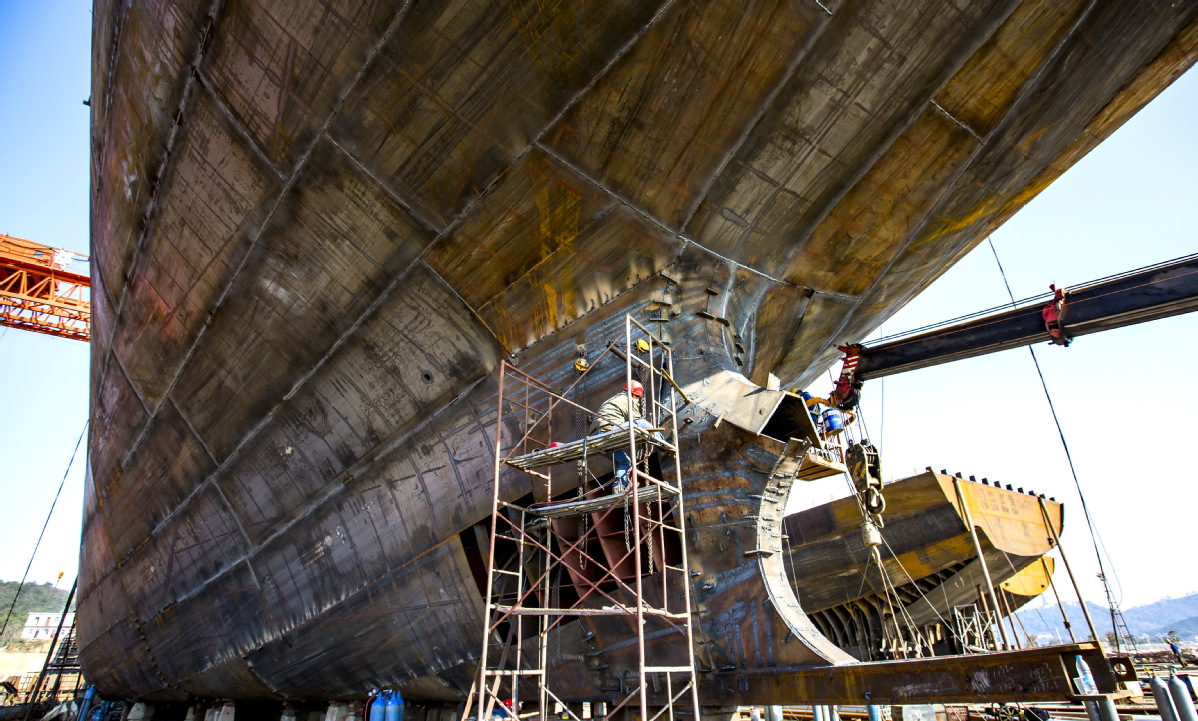Shipbuilders harvest more orders in H1


Firms gear up to tap soaring demand as global shipping revives from COVID woes
The unprecedented boom in global demand for ships in the first half may bode well for Chinese shipyards thirsty for new shipbuilding orders, but the builders are still under pressure to stay profitable, industry experts said.
As new global shipbuilding orders soared 222 percent year-on-year to 74.97 million dead weight tons during the first six months, Chinese shipbuilders received 51 percent of the new orders, or 6.37 million dwt on average per month, the China Association of the National Shipbuilding Industry (CANSI) said.
Leading Chinese shipyards were the direct beneficiaries of the shipbuilding boom. China's shipbuilding giant China State Shipbuilding Corp (CSSC) reported to have delivered 102 vessels from January to June. The group topped global shipbuilders by receiving new orders of 232 ships with an accumulated 18.39 million dwt in the first six months, growing 2.9 times from the same period of last year.
"The year 2021 is Jiangsu Yangzijiang Shipbuilding Group Ltd's best year in history in terms of new orders received," Ren Letian, chairman of Yangzijiang Shipbuilding, was quoted as saying during the company's interim report by Shanghai Securities News.
The nation's largest privately-owned shipbuilder received 112 units of new vessel orders so far this year, with their combined value reaching $6.67 billion. Currently, the company's order book on hand rose to 167 vessels, including 111 container ships.
The orders were mainly the result of revived shipping demand, environmental requirements for vessels, and the impact of the COVID-19 pandemic, industry experts said.
The growing demand since the second half of last year finally spilled into the shipbuilding sector this year, and there appeared to be a pickup on the variety of vessels ordered including container ships and dry bulk carriers among others.
The benchmark Baltic Dry Index (BDI) index surpassed 3,000 this year, reaching its highest level since June 2010, and there is a shortage worldwide in containers as more cargoes awaited transportation, CSSC said.
"Shipping companies are fully confident to place new orders, thanks to the growing shipping demand and rising freight," said Zhou Dequan, director of the Shanghai International Shipping Institute's domestic shipping research office.
Shipping enterprises decided to order new ships because a considerable amount of vessels would be phased out after new rules on energy efficiency take effect, Zhou said.
The confidence of Chinese bulk cargo shipping enterprises reached its highest level in the second quarter, and the willingness to invest in shipping capacity continued to rise during the same period, the Shanghai International Shipping Institute said.
Lin Guolong, director of Shanghai Maritime University's Logistics Research Center, said there are always a certain amount of ships that are phased out or get upgraded on a yearly basis. But the outbreak of the COVID-19 in 2020 somehow delayed that process in the past year, leaving more vessels to be replaced than ever before this year.
"In addition, the recovery in logistics demand, lower financing cost, and reasonable shipbuilding prices all backed the shipbuilding demand," Lin said.
Industry experts said the shipbuilding boom helped ease operations of Chinese shipbuilders as many saw a slump in new orders in the past two years.
While the global order book on hand was nearly halved in volume in 2020 from 2014, many Chinese shipbuilding enterprises experienced a shrinkage in orders the past two years, reaching their lowest level since 2008, CANSI said.
Therefore, the timely placement of new orders allows Chinese shipyards to keep their docks humming with ships being constructed and avoid a suspension in production.
The latest shipbuilding order boom also coincided with a new round of cost increases in the past few months. Therefore, industrial experts suggest Chinese shipbuilders be aware of a rise in commodity prices, and add items for a possible cost hike in their contracts to ensure their profitability.
"Regardless of the challenges, the increase of shipbuilding orders will definitely promote China's shipbuilding industrial chain and supply chain to improve. Chinese shipyards should seize this opportunity to improve their quality, efficiency and capability," Lin said.




































